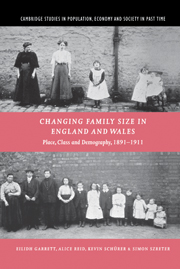Book contents
- Frontmatter
- Contents
- List of figures
- List of tables
- Preface and acknowledgements
- 1 Introduction
- 2 Locations for study
- 3 Studying locations
- 4 Infant and child mortality from the 1911 census
- 5 Fertility and fertility behaviour 1891–1911
- 6 The national picture
- 7 Class, place and demography: the mosaic of demographic change in England and Wales from Waterloo to the Great War
- Appendices
- A The indirect estimation of infant and child mortality and related applications
- B Choice of regression method
- C The values of community-level variables for each sector
- D The percentage of the population of each county living in each type of place, subdivided by envir onment, England and Wales, 1921
- References
- Index
- Cambridge Studies in Population, Economy and Society in Past Time
A - The indirect estimation of infant and child mortality and related applications
Published online by Cambridge University Press: 05 January 2010
- Frontmatter
- Contents
- List of figures
- List of tables
- Preface and acknowledgements
- 1 Introduction
- 2 Locations for study
- 3 Studying locations
- 4 Infant and child mortality from the 1911 census
- 5 Fertility and fertility behaviour 1891–1911
- 6 The national picture
- 7 Class, place and demography: the mosaic of demographic change in England and Wales from Waterloo to the Great War
- Appendices
- A The indirect estimation of infant and child mortality and related applications
- B Choice of regression method
- C The values of community-level variables for each sector
- D The percentage of the population of each county living in each type of place, subdivided by envir onment, England and Wales, 1921
- References
- Index
- Cambridge Studies in Population, Economy and Society in Past Time
Summary
This appendix explains the indirect estimation of infant and child mortality using a worked example to illustrate the basic principles of the techniques and to identify some of the important concepts and assumptions involved. The example uses the numbers of children ever born and children who have died by marital duration for the whole of England and Wales given in the published volumes of the 1911 census.
Indirect techniques involve the use of fertility and mortality schedules. Fertility schedules are a series of fertility rates calculated for different age groups or marital duration groups of women, which describe a childbearing pattern among a cross-section of women at a particular time (a period schedule) or among women born in a particular period (a cohort schedule). Similarly, a mortality schedule is a series of mortality rates, or probabilities of dying for different ages, which describe a mortality regime among a cross-section or a cohort. Life tables are the most common form of mortality schedule, providing the probability of surviving from birth to any exact age.
Calculation of the probability of dying
Brass noticed that of the children born to women in a particular fiveyear marital duration group the proportion who have died corresponds roughly to the probability of dying before a certain exact age.
- Type
- Chapter
- Information
- Changing Family Size in England and WalesPlace, Class and Demography, 1891–1911, pp. 441 - 467Publisher: Cambridge University PressPrint publication year: 2001

